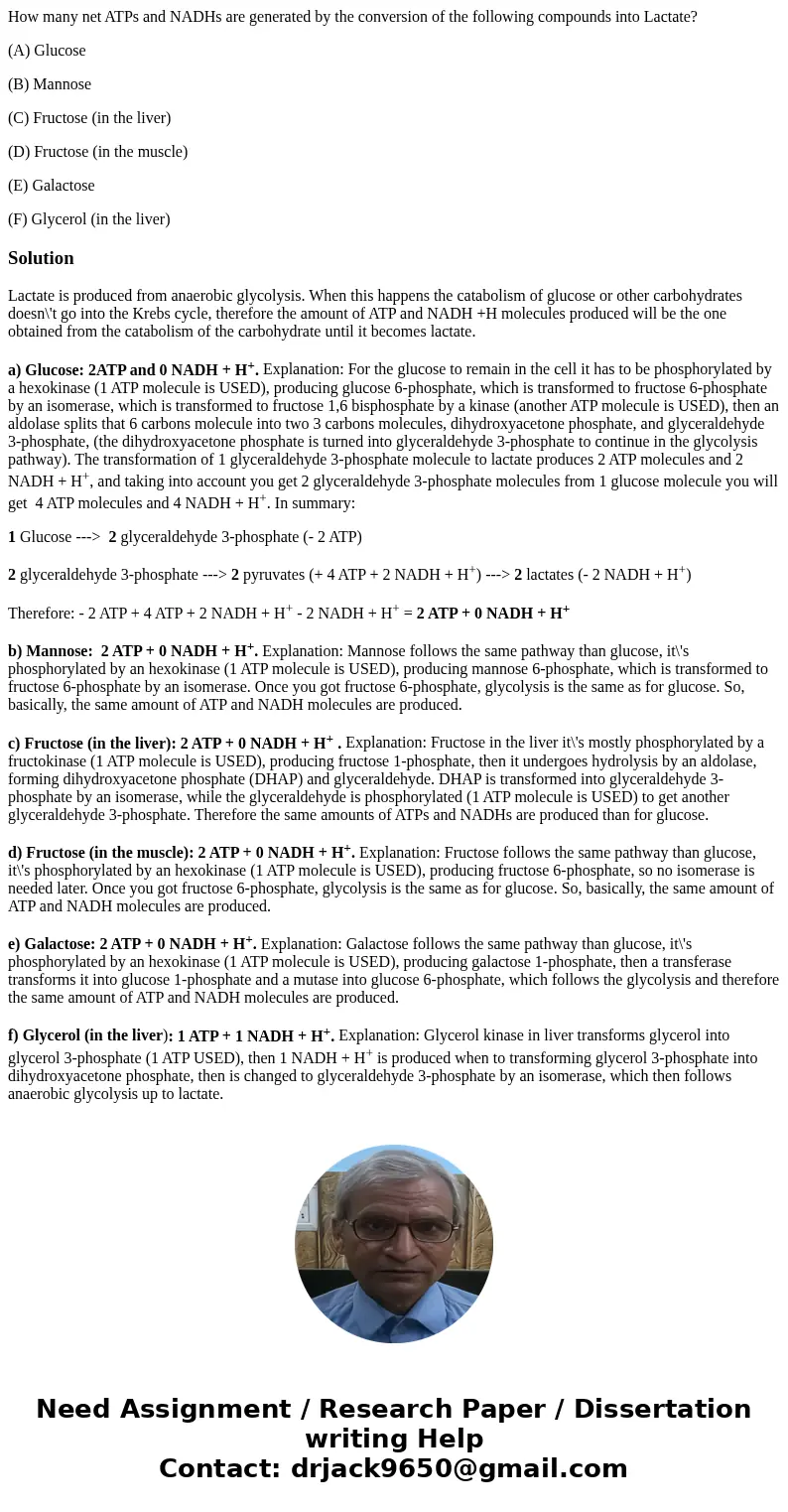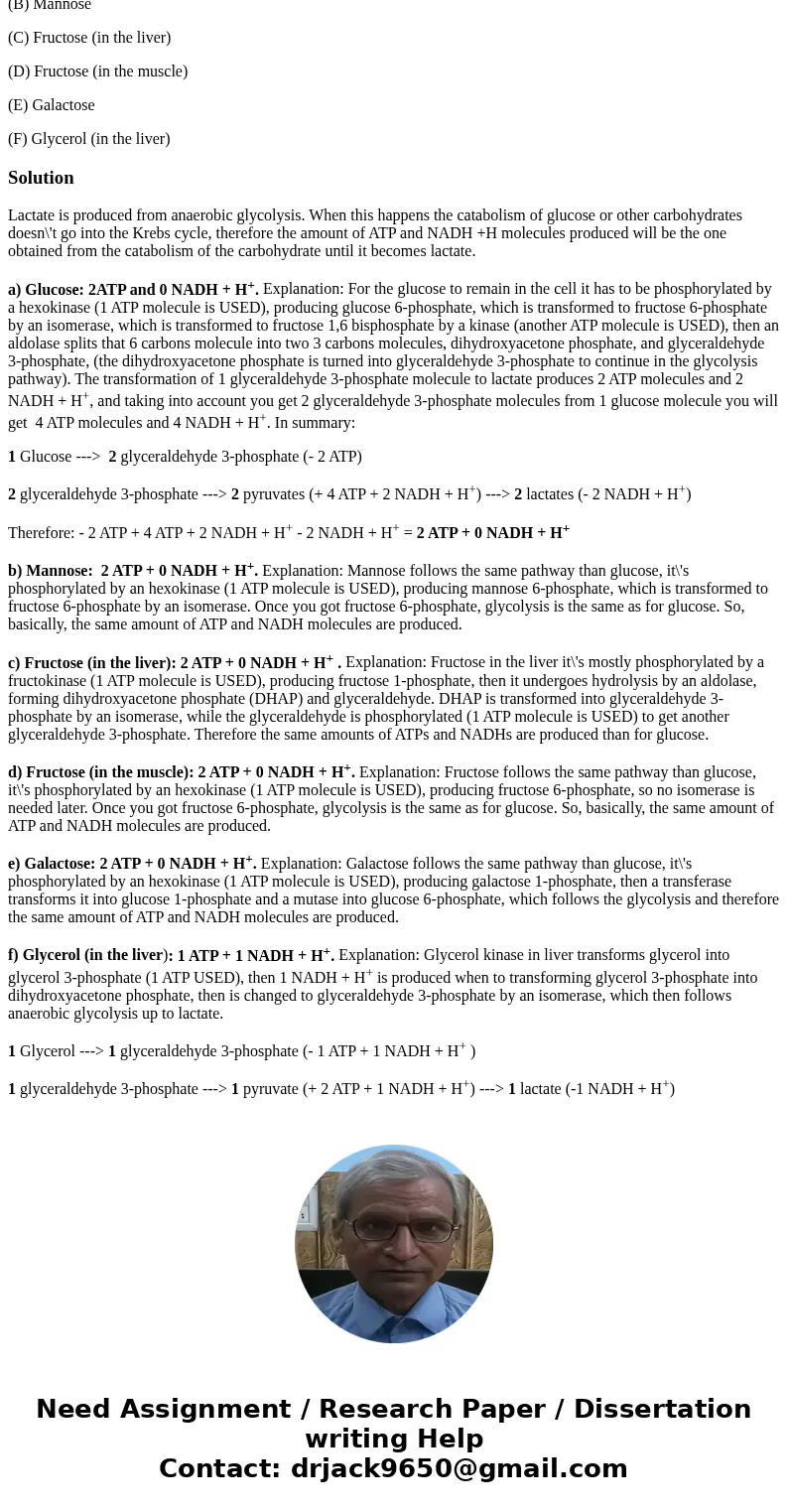How many net ATPs and NADHs are generated by the conversion
How many net ATPs and NADHs are generated by the conversion of the following compounds into Lactate?
(A) Glucose
(B) Mannose
(C) Fructose (in the liver)
(D) Fructose (in the muscle)
(E) Galactose
(F) Glycerol (in the liver)
Solution
Lactate is produced from anaerobic glycolysis. When this happens the catabolism of glucose or other carbohydrates doesn\'t go into the Krebs cycle, therefore the amount of ATP and NADH +H molecules produced will be the one obtained from the catabolism of the carbohydrate until it becomes lactate.
a) Glucose: 2ATP and 0 NADH + H+. Explanation: For the glucose to remain in the cell it has to be phosphorylated by a hexokinase (1 ATP molecule is USED), producing glucose 6-phosphate, which is transformed to fructose 6-phosphate by an isomerase, which is transformed to fructose 1,6 bisphosphate by a kinase (another ATP molecule is USED), then an aldolase splits that 6 carbons molecule into two 3 carbons molecules, dihydroxyacetone phosphate, and glyceraldehyde 3-phosphate, (the dihydroxyacetone phosphate is turned into glyceraldehyde 3-phosphate to continue in the glycolysis pathway). The transformation of 1 glyceraldehyde 3-phosphate molecule to lactate produces 2 ATP molecules and 2 NADH + H+, and taking into account you get 2 glyceraldehyde 3-phosphate molecules from 1 glucose molecule you will get 4 ATP molecules and 4 NADH + H+. In summary:
1 Glucose ---> 2 glyceraldehyde 3-phosphate (- 2 ATP)
2 glyceraldehyde 3-phosphate ---> 2 pyruvates (+ 4 ATP + 2 NADH + H+) ---> 2 lactates (- 2 NADH + H+)
Therefore: - 2 ATP + 4 ATP + 2 NADH + H+ - 2 NADH + H+ = 2 ATP + 0 NADH + H+
b) Mannose: 2 ATP + 0 NADH + H+. Explanation: Mannose follows the same pathway than glucose, it\'s phosphorylated by an hexokinase (1 ATP molecule is USED), producing mannose 6-phosphate, which is transformed to fructose 6-phosphate by an isomerase. Once you got fructose 6-phosphate, glycolysis is the same as for glucose. So, basically, the same amount of ATP and NADH molecules are produced.
c) Fructose (in the liver): 2 ATP + 0 NADH + H+ . Explanation: Fructose in the liver it\'s mostly phosphorylated by a fructokinase (1 ATP molecule is USED), producing fructose 1-phosphate, then it undergoes hydrolysis by an aldolase, forming dihydroxyacetone phosphate (DHAP) and glyceraldehyde. DHAP is transformed into glyceraldehyde 3-phosphate by an isomerase, while the glyceraldehyde is phosphorylated (1 ATP molecule is USED) to get another glyceraldehyde 3-phosphate. Therefore the same amounts of ATPs and NADHs are produced than for glucose.
d) Fructose (in the muscle): 2 ATP + 0 NADH + H+. Explanation: Fructose follows the same pathway than glucose, it\'s phosphorylated by an hexokinase (1 ATP molecule is USED), producing fructose 6-phosphate, so no isomerase is needed later. Once you got fructose 6-phosphate, glycolysis is the same as for glucose. So, basically, the same amount of ATP and NADH molecules are produced.
e) Galactose: 2 ATP + 0 NADH + H+. Explanation: Galactose follows the same pathway than glucose, it\'s phosphorylated by an hexokinase (1 ATP molecule is USED), producing galactose 1-phosphate, then a transferase transforms it into glucose 1-phosphate and a mutase into glucose 6-phosphate, which follows the glycolysis and therefore the same amount of ATP and NADH molecules are produced.
f) Glycerol (in the liver): 1 ATP + 1 NADH + H+. Explanation: Glycerol kinase in liver transforms glycerol into glycerol 3-phosphate (1 ATP USED), then 1 NADH + H+ is produced when to transforming glycerol 3-phosphate into dihydroxyacetone phosphate, then is changed to glyceraldehyde 3-phosphate by an isomerase, which then follows anaerobic glycolysis up to lactate.
1 Glycerol ---> 1 glyceraldehyde 3-phosphate (- 1 ATP + 1 NADH + H+ )
1 glyceraldehyde 3-phosphate ---> 1 pyruvate (+ 2 ATP + 1 NADH + H+) ---> 1 lactate (-1 NADH + H+)


 Homework Sourse
Homework Sourse